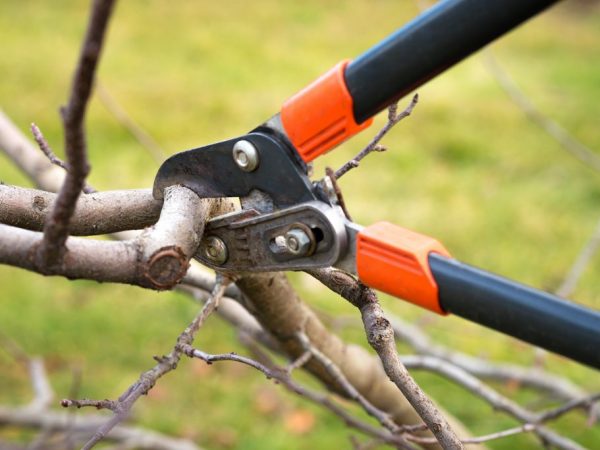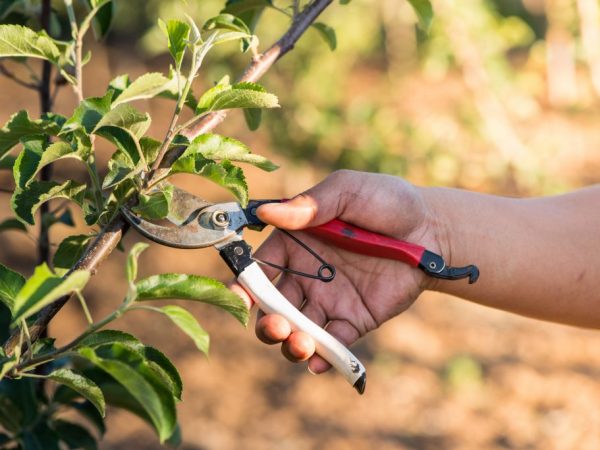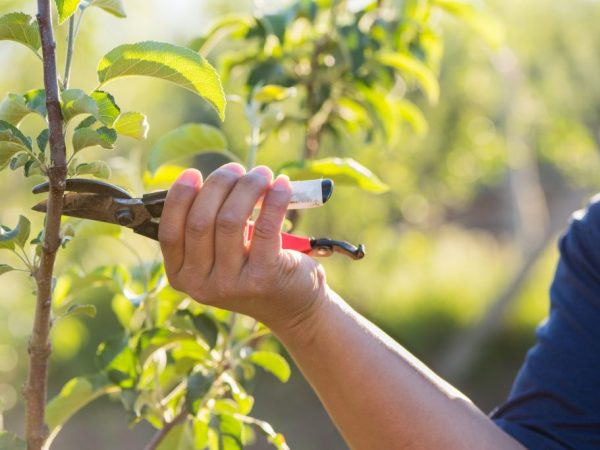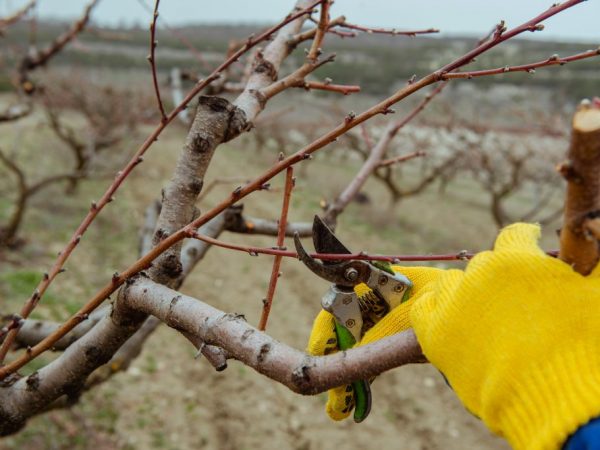Principles of pruning apple trees
Trees need constant care to get rich harvests. In the complex of these procedures, pruning of apple trees occupies an important place, which helps them to develop correctly. This is a whole science that requires certain skills.

Principles of pruning apple trees
Types of trimming
Depending on the purpose, season and condition of the apple tree, the following types of pruning of fruit trees must be used: formative, rejuvenating and sanitary. These manipulations allow you to grow healthy, properly developing trees that will live longer and will yield more yields.
Formative pruning is carried out on young apple trees. The growth of seedlings is always directed upwards, because of this they look thin and elongated (they are drawn to the sun). Most of their energy goes to the formation of the root system, therefore, apple trees cannot increase in width at the first stage of their growth.
Rejuvenating pruning is used for mature crops that are already quite elongated and the root system of which is fully formed. They grow more actively in width, so the lateral shoots must be periodically thinned and trimmed so that the adult tree does not waste energy on their development, but concentrates it on the formation of fruits.
A sanitary procedure is needed for old (blue) apple trees (although experts recommend doing it at all stages). They spend most of their strength on prolonging their lives, and the growth process almost stops. The crown, which has grown during the life of the tree, becomes too heavy for the trunk - it cannot cope with its support.
It becomes more and more difficult for such apple trees to cope with diseases, they begin to bear fruit worse.
Alternative ways
In addition to the above species, there are other ways to prune fruit trees.
Thinning is carried out if a lot of extra, dry or diseased branches have appeared and the crown has become thick. This method is called "under the ring": a stump of a cut branch is left 5-7 mm in size. If it is large, it is recommended to make several cuts (in parts, so as not to peel the bark).
With the help of such a method as shortening, only part of the appendix is removed, i.e. enhancing the growth process and the formation of lateral buds. It can be weak (remove 1/5 of the branch), medium (cut off a third part), cardinal (cut off more than half).
Timing
Carry out pruning of apple trees at a certain time. The procedure is carried out 3 times a year. They are pruned at suitable numbers according to the lunar calendar in spring, autumn and summer. Do not forget about the peculiarities of the region and the climate in which they grow.
Lunar calendar
Use the lunar calendar, because the night star affects all biological processes that occur in trees.In it, you can see at what time it is better to remove excess branches so that fruiting in the current year has a good result. The movement of the sap is more active during the waxing moon, therefore, the branches are cut off for the waning moon.
Auspicious days for pruning will be the following:
- March: 9, 10, 15-19, 24-27;
- April: 3, 4, 5, 9-13, 18, 19;
- September: 3-5, 8-11, 17, 18 (for early varieties);
- October: 4-8, 11, 15, 16-19, 24-28;
- November: 2, 3, 5-8, 12-16, 22 (for winter varieties and weather permitting).
In the summer, the lunar calendar does not recommend the procedure.
You cannot prune branches on a new moon or full moon, when the cycle of the luminary changes.
Depending on the region
Because apple trees in our country grow in all regions, the timing of circumcision, respectively, will be different.
In southern regions, where winters are mild and warm, you can start cutting apple trees at the end of February or early March. In summer, in hot climates, shoots are not recommended to be touched due to insufficient moisture.
In the northern regions, on the contrary, pruning begins in late April or early May (depending on the weather), and the autumn procedure is done in September. Early varieties grow here, because winter ones often do not have time to ripen.
Tools

The pruner is very handy for pruning apple trees
To prune trees, you should use tools made of quality materials, well sharpened and always clean so as not to infect the apple tree. The main set consists of the following items:
- lopper;
- garden knife (for beginners);
- sharpened saws;
- secateurs (it is quite enough for processing a young apple tree), it is better to choose a bypass view;
- telescopic pole (so as not to use a ladder or ladder).
Cropping by season
The season plays an important role in pruning because the sap inside the apple tree moves differently depending on the season. Trees are pruned in three ways:
- "On the kidney" (get rid of one-year increments);
- "On a branch" (removal of two-year-old shoots);
- "On the ring" (cut off completely those of them that interfere with or are infected with the disease).
In the spring
Spring pruning is considered to be the most useful because the sap has not yet begun its active movement and the tree is at rest. The best time is the end of March or the beginning of April, but if it is still frosty outside, then the procedure should be postponed to a more suitable time.
Remove branches spoiled during the winter and make medium pruning of new ones. Thin out heavily overgrown apple trees. After the procedure, it is worth carefully processing the sections so that they do not begin to dry out. Young trees (annual / biennial) need very careful pruning because they are not yet strong.
In summer
A summer cottage or garden does not remain without pruning fruit trees in the summer, but at this time only a cosmetic procedure is carried out:
- dry and weak branches are removed;
- pinch the growth;
- break out unnecessary shoots;
- carry out pruning of vertical tops.
In summer, there is a process of accumulation of nutrients in the leaves and small shoots, active development, growth of fruits (especially in June-July) and the greatest circulation of juice (in early varieties of apple and pear) take place.
In autumn
It is useful to carry out the procedure for pruning trees in the autumn, but only after the leaves have fallen. September, October and even November are suitable in time, if the weather permits and frosts have not come (at sub-zero temperatures, it is strictly forbidden to do this, otherwise the apple tree may die).
After harvesting, it spends much less energy, the circulation of the sap is reduced, and the branches are less active in growth.
The nuances of pruning by age

We remove only unnecessary shoots
The shape and variety of the apple tree is of great importance in the pruning process. In addition, for each age, certain techniques and principles of shoot removal are applied.
Young apple trees
Young apple trees should be pruned in the second year after planting.Carbovka is a type of pruning (from one-year-old to five-year-old) that helps stimulate the growth of branches and the emergence of shoots from dormant buds.
The rule is as follows: above the bud from which a new branch should grow, a cut of the bark is made along with a piece of wood. So the juice that rises from the trunk will linger in front of the bud and accelerate the formation of a branch from the cut shoot. To slow down the growth process, incisions are made under it.
Old apple trees
In autumn, for mature apple trees, pruning is carried out, which is called crowning. The tree gets rid of specific branches, parts of the crown. This helps to significantly increase the yield level. This method removes the growths of mistletoe and those branches that interfere with power lines and buildings.
Crowning reduces the influence of wind, rejuvenates the trunk and makes the tree healthier. This process is performed once every 4 years (in a lean year), but the variety, growth and development features are taken into account. the procedure is very traumatic for the apple tree.
Pruning of old apple trees is carried out "under the ring": this contributes to the establishment of new healthy buds for the next harvest.
Dwarf apple pruning
Dwarf apple trees require special care, and the rules for pruning them differ from the standard ones. In the first year of life in a short apple tree, cut off the top of the head by 50-60 cm (they do this after the first harvest, in the fall), and then shorten the central conductor every year.
At the age of five, it is removed and the formation of the crown begins. On dwarf and semi-dwarf trees, branches sag very much during fruiting, so in the spring they are shortened as much as possible so that the fruits are formed closer to the skeletal sprouts. At a more mature age, every third new branch is removed from such apple species.
The overgrown tree is cleaned of old branches and can give it a pyramidal shape. Consider the peculiarities of planting ordinary and dwarf apple trees in the garden. Plant columnar and dwarf crops separately from standard crops. So they will retain active fruiting and large apple trees will not interfere with the correct formation of the tops in ornamental varieties.
Rules for pruning decorative apple trees
Many of the novice gardeners mistakenly believe that it is much easier to care for ornamental varieties, but you can achieve good shape and a high yield only by observing all the principles of tree care.
Even one-year-old seedlings need pruning and subsequent care (pay special attention in the early years to the guide, as it serves as the basis for crown formation).
Basic principles of pruning:
- you need a special tool for work;
- the time must be selected according to the weather or the lunar calendar;
- follow the golden rule: it is easier to periodically thin out the culture than to deal with a neglected form later, so carry out the procedure systematically.
The rules for cutting the apple tree must be strictly followed. The main principle is moderation. If you cut too much, the number of shoots from the central branches increases. If the circumcision is weak, then the bases of the two-year-old are bare. The second tier, when forming, should be 4-6 branches more than the conductor.
A large number of wounds cannot be done in one approach (year). Do not injure the trunk and bark of annual apple trees. If the fruiting branch is sick, neglected, old or broken, it must be removed to the healthy part, otherwise the sections may not heal.

Correct pruning won't make the apple tree suffer
If you remove the shoot, then the stump should not be left. Correct pruning is carried out at the very trunk or main branch. The cut of tops should be the same size as the kidney itself. Cut off the lower branches as soon as apples stop growing on them (or there are several times less of them), thereby you will raise the height of the bowl.
The central shoot is important for the seedling. It is formative for a young (one-year-old) tree. While the apple tree is growing vigorously, cut off only a third of the length.For three-year-olds, half. If the size of the apples is large, then the branches are propped up so that they do not break.
When harvesting and pruning, do not climb a tree to avoid damaging the bark and breaking branches. Better to use a stepladder or special stands. In order not to remove the frozen part, do not tighten with trimming. An apple tree on a strong rootstock should not exceed 3.5 m in height.
Tree care
Even pruning according to all the rules does not guarantee that the tree will remain in excellent condition. After each manipulation with branches and bark, the apple tree needs special care.
The correct processing of the branches depends on the variety, type of rootstock, age of the seedling. Pruning fruiting apple trees should be combined with preventive measures (protection from insects and diseases, removal of excess ovaries). There are special recommendations for beginner gardeners.
Barrel processing
With temperature drops or in severe frosts, the bark of apple trees can crack, which can cause the tree to become infected with diseases or dry out. Cracks occur due to direct sunlight hitting the apple tree (burns of the bark and top appear). It is better to treat large wounds with special products.
Shallow cracks on old branches should be covered with varnish-based paint. Cuts of healthy branches are processed in the same way in order to avoid intensive drying out.
Apple trees are a winter treat for animals, especially hares, which can chew on most of the trunk. To avoid this, the tree is wrapped with a net with a height of about 1 m.To prevent the trunk from freezing, thick paper can be wound under the net or straw can be tamped.
Even in the northern regions, frost-resistant varieties need insulation so that the apple tree does not freeze.
Insects are also a danger to the bark. In order to disinfect the tree and scare off some of the pests, whitewashing of the trunks is carried out in the spring. The mixture for this is bought at a gardening store or prepared independently: in 10 liters of water, you need to dilute 3 kg of lime, 500 g of copper sulfate and 300 g of wood glue (it serves for better adhesion of the mixture to the bark).
Next, a soft bristled brush is used to treat the barrel with the mixture. If possible, update the whitewash in the summer. Other types of wood processing are also used against pests. Spraying solutions are very popular: "Harvest", "Cotton", "Zeus".
Top dressing
Fruiting apple trees, after pruning, especially need feeding.
Scheme:
- in spring - 2 times (at the beginning, after pruning and after flowering);
- in autumn - 1 time after harvest.
Wrong, incl. too intensive, feeding during planting can greatly harm the tree.
Fertilizers for adult fruiting apple trees:
- based on phosphates (superphosphate, amofos) - it is better to use them in the spring, because they have a high dose of nitrogen, which stimulates the growth and development of the apple tree, 10 g of the mixture is used per 1 m² of the trunk circle;
- on the basis of potassium ("Ecoplant", "Gumitab", "Plantafol") - add these preparations before winter, they help to support the immunity of the tree;
- phosphate-potassium fertilizers are mixed fertilizers that are 100% absorbed by the tree (because of this, its price is higher), they are used for whimsical, dwarf, columnar and fusiform apple trees.
Top dressing is applied at the root. If they are liquid, then grooves are made in the trunk circle and fertilizers are poured into them (the more holes, the stronger the effect).
To apply dry makeup, first remove the top layer of soil (3-4 cm), distribute the mixture evenly, and then sprinkle it with earth. Such mixtures are more useful before winter, because with melted snow, they will gradually penetrate to the roots.
Errors
The health of the tree and its yield depend on the correctly chosen pruning scheme. To make apple trees please you with both appearance and fruits, do not make these most common mistakes:
- lack of pruning of apple trees on the rootstock (especially on trellises);
- untimely carrying out of the procedure;
- lack of pruning of the upper part of the tree - if you do not prune the tops, it will become too fluffy and weak;
- hemp left on the apple tree;
- lack of processing of cuts - each branch, the diameter of which is more than 1.5 cm, needs this procedure, otherwise there will be a possibility of drying out;
- pruning a young tree (two or three years old), which does not need this - this way you can greatly harm the process of growing an apple tree in height;
- excessive shortening of the branches that form the crown;
- incorrect pruning of large branches of an apple tree - scuffs form on the bark, which then have to heal for a long time;
- the introduction of an excessive amount of nitrogen fertilizers - because of this, extra tops are formed;
- tree rejuvenation in one year - it is better to stretch it for 2-3 seasons.

